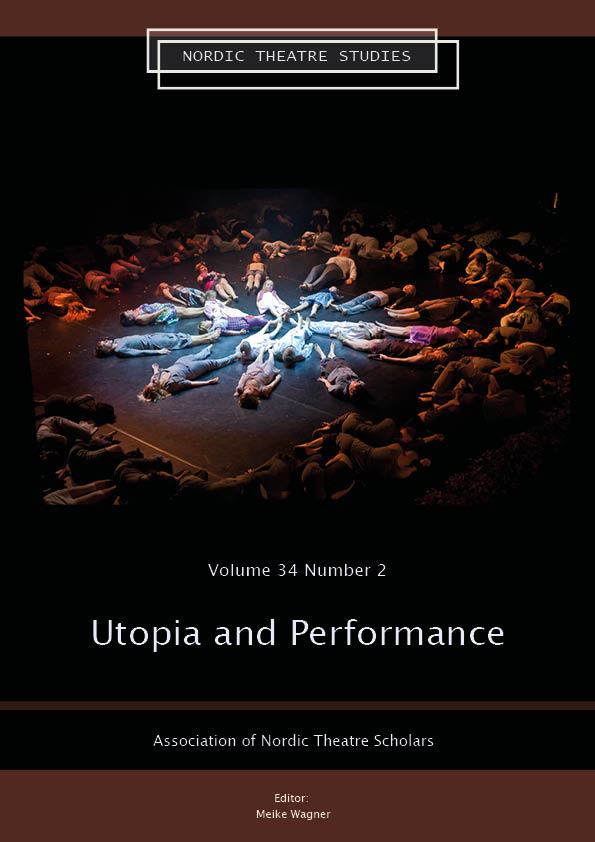Utopian Realism
The Struggle for Positive Peace in Frida Stéenhoff’s Stridbar ungdom (1907)
DOI:
https://doi.org/10.7146/nts.v34i2.141665Keywords:
Frida Stéenhoff, militarism, peace drama, positive peace, Stridbar ungdom, utopian realismAbstract
Around the turn of the nineteenth century writer, and opinion leader, Frida Stéenhoff (1865–1945), developed a theory of the future and the present of society, and argued that contemporary ideas of the social, ethical, and aesthetical were provisional, not comparable to the coming. An affinity between drama and theory, as well as investigations of peace as an idea, are distinctive features of her writing. Her play, Stridbar ungdom / Pugnacious Youth (1907), can be positioned in a tradition of peace dramas spanning from Aristophanes’ Lysistrata to Sarah Kane’s Blasted. This article studies the utopian potential of peace in Pugnacious Youth. By reading the play with Ruth Levitas’ method the Imaginary Reconstitution of Society (IROS) – suggesting that utopia is a method rather than a goal in itself – peace does not emerge negatively, as non-war, but as concrete development and possible presence. Furthermore, the division between realism and idealism when it comes to militarism and peace, as well as the realist and idealist branches of the peace movement, are problematized. In conclusion, it appears that studying ideas of peace in fiction enables an alternative entry into the actualization of its not-yet-here quality.
References
–dh. 1906. “Teater. Doktorinnan Stéenhoffs nya pjäs”, Gefle dagblad, 2/11/1906.
Ahlbäck, Anders, and Fia Sundevall. 2019. “Värnpliktsstrecket - en självklarhet som vändes till sin motsats?” Arbetarhistoria 170–171:2-3, 30-5.
Ahlund, Claes. 2004. “En mental militarisering: Den svenska litteraturen före och under första världskriget.” Samlaren 124, 134–57.
Ahlund, Claes. 2005. “Krig och kultur i konservativ och radikal belysning: Annie Åkerhielm och Frida Stéenhoff från sekelskiftet till första världskriget.” Samlaren 126, 97–150.
Bloch, Ernst. 1977. Das Prinzip Hoffnung: in fünf Teilen. Frankfurt a.M.: Suhrkamp.
Carlsson Wetterberg, Christina. 2010. -bara ett öfverskott af lif-: en biografi om Frida Stéenhoff (1865–1945). Stockholm: Atlantis.
Cockburn, Cynthia. 2012. Anti-militarism: Political and Gender Dynamics of Peace Movements. New York: Palgrave Macmillan.
Galtung, Johan. 1969. “Violence, Peace, and Peace Research.” Journal of Peace Research 6:3, 167–91.
Gittings, John. 2012. The Glorious Art of Peace: From the Iliad to Iraq. Oxford: Oxford University Press.
Hannah, Patricia A. 2014. “Eirēnē: Ancient Greek Goddess and Concept of Peace.” In Takashi Shogimen and Vicky A. Spencer (eds.). Visions of Peace: Asia and the West. New York: Routledge, 11–28.
Hjordt-Vetlesen, Inger-Lise. 1993. “Modernitetens kvinnliga text. Det moderna genombrottet i Norden.” In Møller Jensen, Elisabeth and Inger-Lise Hjordt-Vetlesen (eds.). Nordisk kvinnolitteraturhistoria Bd 2 Fadershuset: 1800-talet. Höganäs: Wiken.
Howard, Michael Eliot. 1961. The Franco-Prussian War: the German Invasion of France, 1870–1871. London: Hart-Davis.
Johansson, Alf W. 2018. Introduction to Kant, Immanuel. Om den eviga freden: ett filosofiskt utkast Translated by Alf W. Johansson. Göteborg: Daidalos, 9–45.
l–n–. 1906. “Stridbar ungdom. En märklig premiär och en märklig succes”, Arbetarbladet, 2/11/1906.
Lamb, Christina. 2021. Våra kroppar, deras slagfält: vad krig gör med kvinnor. Translated by Hillevi Jonsson. Stockholm: Natur & Kultur.
Ledger, Sally. 1997. The New Woman: Fiction and Feminism at the Fin de Siècle Manchester: Manchester Univ. Press.
Lettevall, Rebecka. 2009. “Fred i tiden: modern och senmodern fred speglad i nobelprisen.” In Magnus Jerneck (ed.). Fred i realpolitikens skugga Lund: Studentlitteratur, 49-64.
Levitas, Ruth. 2013. Utopia as Method: the Imaginary Reconstitution of Society Basingstoke: Palgrave Macmillan.
Mårsell, Maria. 2021. “Militarismens ontologi: Krig och fred som mänskliga existensvillkor i Frida Stéenhoffs ‘Stridbar ungdom’ och Elin Wägners ‘Släkten Jerneploogs framgång’” Tidskrift för litteraturvetenskap 51:1-2, 129-37.
Palme, Sven Ulric. 1975. “Krig och fred i konsten.” In Ulf G. Johansson (ed.) Bilder ur svenska historien: en konstbok från Nationalmuseum Stockholm: Rabén & Sjögren, 9-28.
“Så påverkade utvandringen till Amerika Sveriges befolkning.” 2013. Statistiska centralbyrån. https://www.scb.se/hitta-statistik/artiklar/2013/sa-paverkade-utvandringen-till-amerika-sveriges-befolkning/ (23.2.2022).
Sargisson, Lucy. 2007. “The Curious Relationship Between Politics and Utopia.” In Tom Moylan and Raffaella Baccolini (eds.). Utopia Method Vision: the Use Value of Social Dreaming Bern: Peter Lang AG, 25-46.
Shōgimen, Takashi and Vicki A. Spencer. 2014. “Introduction” In Takashi Shogimen and Vicky A. Spencer (eds.). Visions of Peace: Asia and the West New York: Routledge.
Stéenhoff, Frida. 1907. Stridbar ungdom: skådespel i tre akter Malmö: Socialdemokratiska Ungdomsförbundets förlag.
Stéenhoff, Frida. 1933. Svek: tre vanvördiga akter om viss politik Stockholm: Björck & Börjesson.
Szondi, Peter. 1972. Det moderna dramats teori, 1880-1950. Translated by Kerstin Derkert. Stockholm: Wahlström & Widstrand.
Wilson, Catherine. 2017. “Leibniz on War and Peace and the Common Good.” In Wenchao Li (ed.). “Für unser Glück oder das Glück anderer”: Vorträge des X. Internationalen Leibniz-Kongresses, Hannover, 18.-23. Juli 2016 Hildesheim: Georg Olms Verlag, 33-62.
Young, Nigel J. 2010. The Oxford International Encyclopedia of Peace New York: Oxford University Press.
Zade, Beatrice. 1935. Frida Steenhoff: människan, kämpen, verket Stockholm: Bonnier.
Downloads
Published
How to Cite
Issue
Section
License
The copyright belongs to the authors and Nordic Theatre Studies. Users can use, reuse and build upon the material published in the journal but only for non-commercial purposes. Users are allowed to link to the files, download the files, distribute the files on a local network (preferably by links), upload the files to local repositories if their institutions require them to do so, but not republish the files without proper agreements with the journal and the author.

